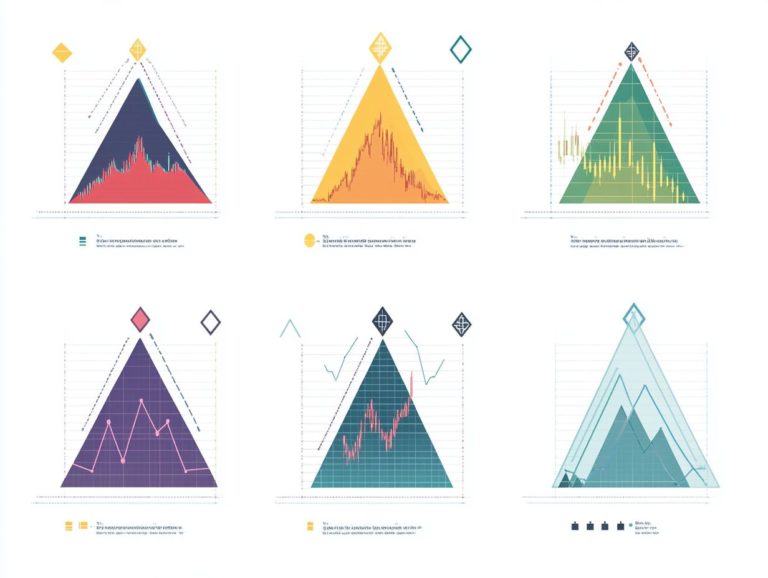Interpreting Market Indicators for Better Decisions
Market indicators serve as vital instruments that empower you to navigate the intricate landscape of financial markets with confidence.
This guide delves into the various types of indicators and underscores their significance in shaping your decision-making and predicting trends. It examines essential economic, technical, and sentiment indicators while addressing common pitfalls in interpretation to keep you on track.
You’ll discover effective strategies for leveraging these insights, ensuring you make informed choices.
Whether you’re a seasoned investor or just embarking on your financial journey, mastering market indicators can significantly boost your investment success!
Contents
Key Takeaways:

- Market indicators are key statistics that provide insights into the state of a market. They can help you make better decisions by helping you understand market trends and potential risks.
- Interpreting market indicators requires considering various factors and avoiding common mistakes. Economic, technical, and sentiment indicators should be carefully monitored for a comprehensive understanding of the market.
- To effectively use market indicators for decision-making, it is important to have a strategy in place and follow best practices. These may include setting goals, diversifying indicators, and regularly reviewing and adjusting your approach.
Understanding Market Indicators
Understanding market indicators is crucial for you as an investment professional, as they offer valuable insights into the health of the economy and can profoundly influence your investment decisions in the stock market.
These indicators, including economic and technical types, give you the power to interpret market trends, gauge investor sentiment, and analyze financial metrics. By doing so, you can refine your ways to manage your investments and enhance your predictive analytics, ultimately leading to more informed investment choices.
Definition and Types of Market Indicators
Market indicators are invaluable tools for you as an investor or analyst, allowing you to assess both the performance and potential trajectory of the stock market. These indicators come in various forms, including economic indicators like GDP and the consumer price index, as well as technical indicators such as moving averages and market breadth metrics.
They not only provide vital information about current market conditions but also offer insights into future trends and prevailing investor sentiment. Economic indicators, like the unemployment rate, can shed light on consumer spending trends, while the producer price index may hint at inflationary pressures.
On the technical side, indicators like the Relative Strength Index (RSI) and Bollinger Bands a technical tool that helps identify market volatility allow you to dissect price movements and identify optimal entry or exit points. By scrutinizing both leading indicators, which forecast future movements, and lagging indicators, which validate past trends, you can gain a well-rounded understanding of market dynamics.
This comprehensive insight ultimately enables you to make more informed and strategic investment decisions.
Why Market Indicators are Important
Market indicators are essential for shaping your investment decisions, enabling you to assess economic performance and pinpoint the trends that influence your strategies.
By analyzing a range of indicators, including stock market indices and financial index data, you can gain deeper insights into market sentiment.
This understanding gives you the power to make informed choices that align with your investment objectives and enhance your overall strategy.
Start using market indicators today to elevate your investment strategy!
Impact on Decision Making and Predicting Market Trends
The impact of market indicators on your decision-making process is significant. These indicators provide critical data that give you the power to predict market trends and adjust your investment strategies. This enables you to make more informed choices in an ever-evolving financial landscape.
Tracking consumer confidence surveys offers valuable insights into potential spending habits. Fluctuations in employment data often signal shifts in economic momentum. By analyzing revenue growth across various sectors, you can pinpoint industries that are ripe for expansion.
Paying attention to investor sentiment whether bullish or bearish can help you strategically position yourself in asset classes that may outperform in specific market conditions. Incorporating these indicators into your analysis allows you to make calculated decisions that align with market realities, ultimately leading to optimized returns.
Interpreting Market Indicators

Understanding market indicators is crucial for smart investing, as it requires nuanced analysis of both technical and economic signals to grasp the underlying market sentiment.
By using advanced data analysis techniques, you can uncover valuable insights from historical data and identify key market trends.
However, be cautious; misinterpretations can lead to costly errors that significantly impact your investments.
Factors to Consider and Common Mistakes to Avoid
When interpreting market indicators, consider various factors for accurate analysis. Understanding the context of market sentiment is crucial. Avoiding common pitfalls that could skew your investment decisions is also essential.
Timing plays a pivotal role; shifts in market conditions can significantly alter an indicator’s relevance. The interplay between different indicators such as economic data, earnings reports, and geopolitical events offers a richer perspective on the overall landscape.
Be mindful of the tendency to rely too heavily on a single metric, as it can lead to a narrow view. To avoid such traps, engage in thorough data analysis that incorporates multiple indicators. This approach enhances your decision-making process and minimizes the risks associated with uninformed choices.
Types of Market Indicators to Watch
Keep an eye on several types of market indicators to refine your investment strategies.
- Economic indicators: GDP and the Consumer Price Index provide a macro view of the economy.
- Technical indicators: Tools that help you analyze price trends, such as moving averages.
- Sentiment indicators: Assess investor mood, giving you insight into market psychology.
Each of these indicators offers distinct insights into market conditions and potential price movements, allowing you to make more informed investment decisions.
Economic Indicators
Economic indicators like Gross Domestic Product (GDP), Consumer Price Index (CPI), and unemployment rates are essential metrics that provide valuable insights into the health of the economy. They guide your investment strategies in the stock market.
Grasping how these indicators reflect the overall economic climate is crucial for you as an investor. For instance, GDP measures the total value of all goods and services produced in your country. It acts as a barometer of economic activity. A growing GDP typically signals a thriving economy, inspiring you to invest. In contrast, a declining GDP may prompt you to exercise caution.
Similarly, the CPI tracks changes in consumer prices to gauge inflation, indicating trends in purchasing power. Rising inflation might lead you to rethink your portfolio. Unemployment rates further illuminate labor market conditions, with higher rates often hinting at economic distress, which can trigger bearish market trends.
By analyzing these indicators collectively, you arm yourself with the knowledge needed to make informed decisions tailored to current market conditions.
Technical Indicators
Technical indicators, such as moving averages, market breadth measures, and the advance-decline line, serve as essential analytical tools for assessing market price movements and uncovering potential trading opportunities.
These tools also provide valuable insights into the underlying trends and momentum of a stock or index, empowering you to make informed decisions. For example, moving averages help to smooth out price data, providing a clearer direction for trends. The 50-day and 200-day averages are particularly useful for gauging short- and long-term market sentiment.
Market breadth measures, which show the count of advancing versus declining stocks, can indicate the overall strength or weakness of the market. The advance-decline line further visualizes this balance, delivering a more comprehensive view of market health.
Integrate these indicators into your trading strategies to boost your chances of success in navigating the complexities of market dynamics.
Sentiment Indicators

Sentiment indicators are essential for evaluating both investor and market sentiment, providing valuable insights into market trends and potential future price movements that can shape your trading strategies.
By assessing the collective mood of investors, these indicators empower you to anticipate market shifts, leading to more informed decision-making. Take, for example, widely used tools like the Investor Sentiment Index and the VIX (Volatility Index), which gauge the levels of fear and greed among market participants.
When you spot extreme bullish sentiment, it might be a signal that a market correction is on the horizon. Excessive bearish sentiment may hint at a potential reversal. Grasping these nuances allows you to skillfully navigate the complexities of market behavior, aligning your strategies with overarching trends to optimize your returns.
Using Market Indicators for Better Decisions
Utilizing key indicators for analyzing market trends effectively empowers you to make more informed investment decisions, offering critical insights that enhance your trading strategies and overall portfolio management.
By aligning your investment strategies with real-time data from these indicators, you can optimize your financial advisory services and respond proactively to emerging market trends.
This approach sharpens your competitive edge and positions you for greater success in navigating the complexities of the financial landscape.
Strategies and Best Practices
Developing effective strategies and best practices for utilizing market indicators can significantly elevate your portfolio management and trading strategies, paving the way for more informed investment decisions and improved financial metrics.
Begin by identifying key indicators that align with your specific investment goals think volatility indices or economic reports to ensure that you’re gathering the most relevant data. Incorporating advanced analytical tools can enhance your ability to dissect this data, providing nuanced insights that inform strategic adjustments.
Regularly monitoring these indicators is essential; real-time adjustments based on market conditions can profoundly influence your performance. By establishing a feedback loop where your strategies are tested and refined based on observed outcomes, you can adopt a more adaptive approach, ultimately optimizing your investment portfolio in an ever-evolving marketplace.
Frequently Asked Questions
What are market indicators?
Market indicators are numbers or stats that show how well a market or economy is doing.
Why is it important to interpret market indicators?

Interpreting market indicators allows individuals and businesses to make informed decisions about investments, budgeting, and overall financial strategies, as outlined in our guide on understanding market indicators and their trends.
What are some common market indicators?
Common market indicators include stock market indexes, GDP, inflation rates, consumer spending, and interest rates.
How can market indicators help make better decisions?
Analyzing market indicators gives you insight into market trends. This helps you spot potential risks and growth opportunities.
What are some tips for interpreting market indicators?
Understand the context of the data you re looking at. Consider multiple indicators and don t hesitate to seek expert advice!
Can market indicators predict future trends?
Market indicators offer valuable insights into current conditions. However, they should be just one tool in your decision-making toolbox, alongside political events and global economic factors.






